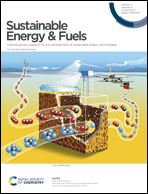Patterned interlayer enables a highly stable and reversible sodium metal anode for sodium-metal batteries†
Abstract
The cycle-life of the sodium metal anode in carbonate-based electrolytes is severely challenged by the irreversible consumption of the metal anode and electrolyte inventory. Although ether-based electrolytes can extend the cycle life, their high flammability poses serious safety challenges. Carbonate-based electrolytes are engineered through fluorinated organic additives to minimize consumption; this leads to gradual decay in the capacity due to unwanted side reactions. Here, we present a patterned polypropylene interlayer (PPIL) to stabilize the sodium metal anode in a carbonate-based electrolyte without needing organic additives. The PPIL helps to minimize electrolyte consumption in carbonate- and ether-based electrolytes. With the optimized patterned design and thickness of the PPIL, the Na metal anode could function reversibly for an unprecedented 9000 cycles at a relatively high current density of 10 mA cm−2 in the carbonate-based electrolyte. Moreover, the sodium metal anode survives in the ether-based electrolytes for over 2000 cycles at 10 mA cm−2. We demonstrate the feasibility of developing a stable and long-lasting sodium-metal battery comprising Na-PPIL//Prussian blue analogue that operates at room temperature and lasts more than 250 cycles without significantly losing capacity. This work highlights the significance of the patterned interlayers in stabilizing the sodium metal anode, irrespective of the chemistry of the electrolytes.



 Please wait while we load your content...
Please wait while we load your content...